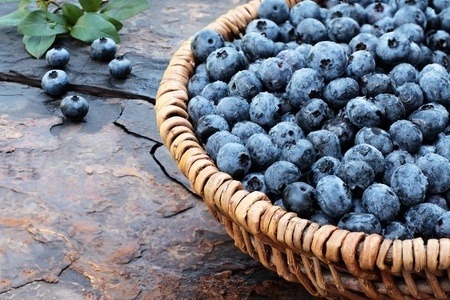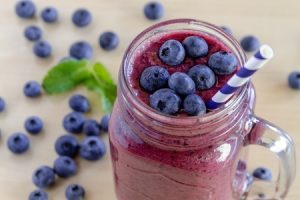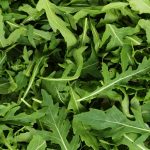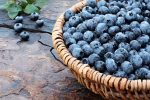
- Blueberries are much sought after because of their high antioxidant properties.
- Benefits include improved cognition, immune health and overall health.
Blueberries are now firmly established as a superfood with their strong nutritional benefit story and with great versatility, either fresh or dried, in a range of fruit based products. A lot of evidence is being developed to support their help upon consumption with improving mental activities including cognition, in raising immune health as well as addressing a host of other general health benefits.
The fruit is consumed widely not just fresh but in muffins and pies. The US Department of Agriculture (USDA) regularly states that consumption of just the fresh fruit rose 3.5 times in the last decade, with greater calls for it abroad and then ever before. In Europe, we know them as bilberries and they grow wild on heathland and acid soils.
Benefits Of Blueberries
Blueberries have a tremendous health and nutrition pedigree and studies continue to uncover their antioxidant, anti-inflammatory and ant-cancer properties (Roy et al., 2009). The fruit was recognised for its important benefits to eyesight during the Second World War in Europe when consumption improved the visual acuity of airmen during night raids. In fact it was a policy for the Royal Air Force, that the crews should eat the fruit regularly because of this feature (Mazza and Miniatti, 1993).
Blueberries are a good source of vitamin C and K and contain manganese but only small amounts of dietary fibre compared to blackcurrants and other pectin rich fruit. The juice yield from blueberries is about 85% w/w.
The first major comprehensive review on both wild and cultivated fruit (Kalt and Dufour, 1997) looked at early studies covering its reduction of coronary heart disease, easing of urinary tract and kidney disorders as well as those conditions mentioned earlier (Kalt et al., 2002). Blueberry components regularly feature in over the counter medicines and even pharmaceutical products because they have a comforting aspect to their inclusion as well as the established health benefits (Rice-Evans et al., 1996; Wang et al., 1997).
One of the most comprehensive assessments of the role that blueberry consumption can have in ameliorating various chronic diseases has been covered by Ma et al., (2018).
Colour And Anthocyanins
The blue- purplish colour is due to anthocyanin pigments which have been comprehensively analysed (Müller et al., 2012) using high performance liquid chromatography (HPLC). The fruit generally is one of the richest dietary sources of these pigments.
The anthocyanin and polyphenolic content and composition of cultivated and wild species is roughly similar between Europe and North America (Francis et al., 1966; Ballinger et al., 1972; Sapers et al., 1984; Azar et al., 1987; Ballington et al., 1987; Macheix et al., 1990; Mazza and Miniati 1993; Gao and Mazza 1994; Kader et al., 1996; Kalt and McDonald 1996).
At least 15 different colour pigments have been found so far (Nyman and Kumpulainen, 2001; Nicoue et al., 2007; Hosseinlan and Beta, 2007; Latti et al., 2008).

There are also a number of flavonoids and other polyphenolics to which has been attributed many of the health benefits. The main flavonoids are flavonols such as kaempferol (Kader et al., 1996), catechins, epicatechin, procyanidins (Stöhr and Herrmann, 1975) and the quercetin-3-o-glycosides (Bilyk and Sapers, 1986). The most abundant cinnamic ester is chlorogenic acid (Schuster and Herrmann 1985; Kader et al., 1996, 1997b). It was realised in the late nineties that the polyphenolic content was one of the highest of all fruits and vegetables based on the oxygen radical absorbing capacity (ORAC) (Prior et al., 1998).
Product Development Issues With Blueberry
Colour is one of the fruit’s most important sensory attributes. The fruit is widely used to provide a dark blue-violet colour to yoghurts for example. Unfortunately in processing terms, the colour pigments are susceptible to oxidative damage and various means to stabilise or minimise the losses have been sought. One of the issues is the action of a polyphenol oxidase which promotes enzymic browning and is promoted by chlorogenic acid (Kader et al., 1997 a & b). Preserving colour also implies protection of the health benefits.
Blueberry And Bilberry Wine
Wine from the blueberry has attracted some interest from researchers who are keen to understand how fermentation alters the health properties of the fruit.
Health Claims
Heart health
A 2012 study of 93,000 women found that those who consumed at least three portions or more of both blueberries and strawberries a week had a 32% lower risk of a heart attack compared with participants who ate berries just once a month or less (Cassidy et al., 2013). The study couldn’t definitely state these fruits lowered the risk but it was a factor to be considered seriously.
Cancer
There is not enough evidence yet that blueberries can help protect against any form of cancer. In laboratory studies on cells and animals, blueberry extracts composed mainly of anthocyanins have been demonstrated to reduce levels of free radical damage that are linked with cancer. Unfortunately, more research is needed to understand whether people absorb these compounds from eating blueberries and whether or not they have a protective effect.
Improved Memory And Cognition From Consumption Of Blueberries
An increasing number of studies have identifed links between blueberry consumption and improved cognitive function, spatial learning and memory. These studies more specifically looked at protecting memory-associated regions in the brain from oxidative damage and slowing age-related damage to brain cells (Williams et al., 2017).
Blueberries are very rich in anthocyanins amongst other flavonoids which are compounds credited greatly for its anti-aging benefits by limiting cellular damage caused by of free radicals and preventing a large array of ailments produced by oxidative stress. Anthocyanins mop up free radicals which largely accounts for their benefits with a number of medical issues. They are present in a range of fruits and there is general interest in their health properties.
One piece of research set the ball really rolling by looking at blueberry beverage consumption and the improvement in people’s level of cognition (Williams et al., 2017). They compared the performance of an anthocyanin-rich blueberry beverage (BB), versus a matched placebo, on vascular and cognitive function in healthy younger and older adults. A number of factors associated with cognitive function including stiffness index (SI), blood pressure (BP) and levels of brain-derived neurotrophic factor (BDNF) were examined at hourly intervals following consumption of the beverages. MRI (Magnetic Resonance Imaging) was used to assess changes in cerebral blood flow (CBF).
Drinking the blueberry beverage produced improved cognitive performance and higher circulating levels of BDNF. There was also better cerebral blood flow in various parts of the brain associated with better memory and cognition. The implication was that the anthocyanins and flavonoids in the blueberry drink generated the cognitive benefits mediated by an action on BDNF signalling pathways, in addition to vasodilatory properties and subsequent CBF increases.
The latest examination was conducted by McNamara et al. (2018) who looked at long-term supplementation in older adults with cognition and memory issues. For 24 weeks, both elderly men and women received daily fish oil or blueberry supplements or both. Those who took either the fish oil or the blueberry supplements described less complaints regarding their level of cognition. The added benefit over fish oil was that blueberry supplementation showed improved memory discrimination as well.
Given that there are many anthocyanin rich fruits in the world, it remains to be seen whether blackcurrants, raspberries and cranberries offer the same benefits.
Blueberries And Eye Health
A recent study showed that blueberry anthocyanins could stop the induction and progression of age-related macular degeneration. The condition associated with loss of vision is thought to be controlled through the antioxidant mechanisms associated with these colour pigments. The study showed that an anthocyanin extract from blueberry reduced oxidative stress in human retinal pigment epithelial cells which was induced by hydrogen peroxide (Huang et al., 2018a).
A similar study found that inflammatory damage to the same endothelial cells caused by high glucose was also minimised by the presence of blueberry anthocyanins. This effect on such cells could be a promising way of combating, if not prevent diabetic retinopathy (Huang et al., 2018b).
Further Research On Blueberries
Whilst research on the health claims of blueberries is not yet wholly conclusive, they are still a fantastic choice as one of your five portions of fruit and vegetables a day. They are low in calories but high in nutrients, including phenolic compounds with an antioxidant capacity significantly higher than vitamins C or E. Dieticians recommend adding them to your breakfast cereal, including them in a packed lunch or mixing with low-fat yoghurt for a delicious dessert.
If you are interested in growing this fruit then consult our pages on cultivation of this delicious and healthy fruit.
Products from Our Affiliate Marketing Partner
Please not this article contains links to our affiliate marketing partner. Please read our affiliate disclosure.
This article was revised on the 22nd November 2018 to incorporate new material relating to eye health, memory retention and brain cognition.
References
Ballington, J. R., Ballinger, W. E., & Maness, E. P. (1987). Interspecific differences in the percentage of anthocyanins, aglycones, and aglycone-sugars in the fruit of seven species of blueberries. J. Amer. Soc. Hort. Sci., 112(5), pp. 859-864.
Bilyk, A., & Sapers, G. M. (1986). Varietal differences in the quercetin, kaempferol, and myricetin contents of highbush blueberry, cranberry, and thornless blackberry fruits. J. Agric. Food Chem., 34(4), pp. 585-588
Cassidy, A., Mukamal, K.J., Liu, L., Franz, Eliassen, A.H., Rimm, E.B. (2013) High anthocyanin intake is associated with a reduced risk of myocardial infarction in young and middle-aged women. Circulation. Jan 15; 127(2) pp. 188-9 doi: 10.1161/CIRCULATIONAHA.112.122408.
Francis, F. J., Harborne, J. B., & Barker, W. G. (1966). Anthocyanins in the lowbush blueberry, Vaccinium angustifolium. J. Food Sci., 31(4), pp. 583-587.
Gao, L., & Mazza, G. (1994). Quantitation and distribution of simple and acylated anthocyanins and other phenolics in blueberries. J. Food Sci., 59(5), pp. 1057-1059.
Hosseinlan, F., Beta, T. (2007) Saskatoon and wild blueberries have higher anthocyanin contents than other Manitoba berries. J. Agric. Food Chem. 55 pp. 10832–38
Huang, W. Y., Wu, H., Li, D. J., Song, J. F., Xiao, Y. D., Liu, C. Q., … & Sui, Z. Q. (2018a). Protective effects of blueberry anthocyanins against H2O2-induced oxidative injuries in human retinal pigment epithelial cells. Journal of Agricultural and Food Chemistry, 66(7), pp. 1638-1648. https://pubs.acs.org/doi/10.1021/acs.jafc.7b06135
Huang, W., Yan, Z., Li, D., Ma, Y., Zhou, J and Sui, Z. (2018) Antioxidant and anti-inflammatory effects of blueberry anthocyanins on high glucose-induced human retinal capillary endothelial cells. Oxidative Medicine and Cellular Longevity, vol. 2018, Article ID 1862462, 10 pages https://www.ncbi.nlm.nih.gov/pubmed/29682153
Kader, F., Rovel, B., Girardin, M., & Metche, M. (1997a). Mechanism of browning in fresh highbush blueberry fruit (Vaccinium corymbosum L). Role of blueberry polyphenol oxidase, chlorogenic acid and anthocyanins. J. Sci. Food Agric., 74(1), pp. 31-34.
Kader, F., Rovel, B., Girardin, M., & Metche, M. (1997b). Mechanism of browning in fresh highbush blueberry fruit (Vaccinium corymbosum L). Partial purification and characterisation of blueberry polyphenol oxidase. J.Sci. Food Agric., 73(4), pp. 513-516.
Kalt, W., & Dufour, D. (1997). Health functionality of blueberries. HortTechnology, 7(3), pp. 216-221.
Kalt, W., McDonald, J. E., & Donner, H. (2000). Anthocyanins, phenolics, and antioxidant capacity of processed lowbush blueberry products. J. Food Sci, 65(3), pp. 390-393.
Latti, A.K., Riihinen, K.R., Kainulainen, P.S. (2008) Analysis of anthocyanin variation in wild populations of bilberry (Vaccinium myrtillus L.) in Finland. J Agric. Food Chem. 56(1) pp. 190–96.
Ma, L., Sun, Z., Zeng, Y., Luo, M., Yang, J. (2018) Molecular Mechanism and Health Role of Functional Ingredients in Blueberry for Chronic Disease in Human Beings. Int. J. Mol. Sci. 2018, 19(9), 2785; https://doi.org/10.3390/ijms19092785 .
Mazza, G., Miniati, E. (1993) Anthocyanins in fruits, vegetables and grains. Florida: CRC Press.
McNamara, R.K., Kalt, W., Shidler, M.D., McDonald, J., Summer, S.S., Stein, A.L., Stover, A.N., Krikorian, R. (2018) Cognitive response to fish oil, blueberry, and combined supplementation in older adults with subjective cognitive impairment. Neurobiology of Aging. 64 April pp. 147-156 https://doi.org/10.1016/j.neurobiolaging.2017.12.003
Müller, D., Schantz, M. and Richling, E. (2012), High Performance Liquid Chromatography Analysis of Anthocyanins in Bilberries (Vaccinium myrtillus L.), Blueberries (Vaccinium corymbosum L.), and Corresponding Juices. J. Food Sci., 77: C340–C345. doi: 10.1111/j.1750-3841.2011.02605.x
Nicoue, E.E., Savard, S., Belkacemi, K. (2007) Anthocyanins in wild blueberries of Quebec: extraction and identification. J. Agric. Food Chem. 55(14) pp. 5626–35.
Nyman, N.A., Kumpulainen, J.T. (2001) Determination of anthocyanidins in berries and red wine by high-performance liquid chromatography. J. Agric. Food Chem. 49(9) pp. 4183–87.
Stöhr, H., & Herrmann, K. (1975). [The phenolics of fruits. VI. The phenolics of currants, gooseberries and blueberries. Changes in phenolic acids and catechins during development of black currants (author’s translation)]. Zeitschrift fur Lebensmittel-Untersuchung und-Forschung, 159(1), pp. 31-37.
Wang, H., Cao, G., & Prior, R. L. (1997). Oxygen radical absorbing capacity of anthocyanins. J. Agric. Food Chem., 45(2), pp. 304-309
Williams, C., Dodd, G., Lamport, D., Spencer, J., Butler, L. (2017) Effects Of Anthocyanin-Rich Blueberries On Cognitive Function In Healthy Younger And Older Adults. Innovation in Aging, 1, Issue suppl_1, 1 July. Pages 1362, https://doi.org/10.1093/geroni/igx004.5009


Leave a Reply